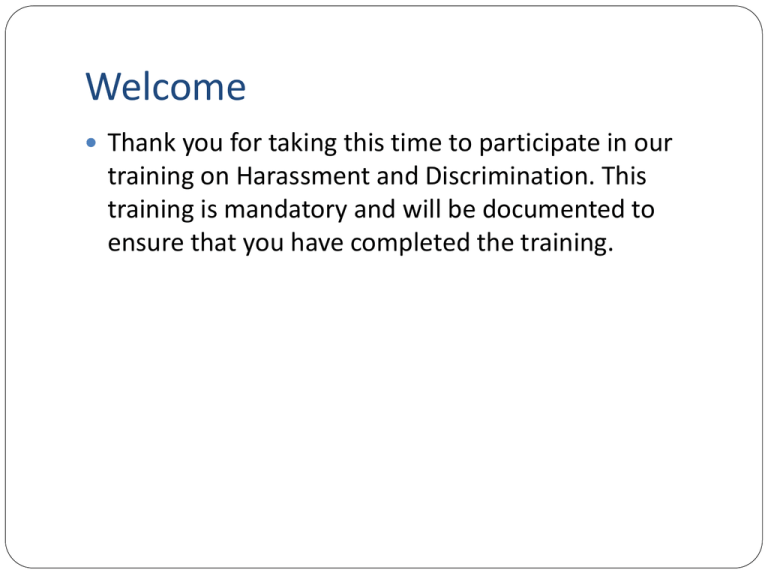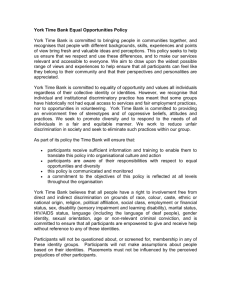
Welcome
Thank you for taking this time to participate in our
training on Harassment and Discrimination. This
training is mandatory and will be documented to
ensure that you have completed the training.
Some Interesting Historical Facts on
Harassment and Discrimination
In 1976, it was noted that 9/10 women in the work force
reported feeling some type of harassment or discrimination
In 1980, it was noted that 42% women and 15% men in the
workforce reported feeling some type of harassment or
discrimination
In an Internet article titled “Sexual Harassment Statistics Sexual Harassment Statistics in the Workplace” written by
Nikki Katz, a telephone poll conducted by Louis Harris and
Associates on 782 workers revealed:
31% of the female workers claimed to have been harassed at
work
7% of the male workers claimed to have been harassed at work
62% of targets took no action
100% of women claimed the harasser was a man
59% of men claimed the harasser was a woman
41% of men claimed the harasser was another man
What Statutes and Regulations Prohibit Harassment
and Discrimination
Numerous Federal Statutes and Regulations prohibit discrimination
The Equal Protection Clause of the Fourteenth Amendment to the United States
Constitution protects against government action that discriminates on the basis of
race, national origin and sex. This constitutional amendment provided the first
protection against discrimination for a specific class of people. Although the
amendment does not specifically mention race, the intent when it was passed at
the end of the Civil War was clear-the states were required to treat all citizens,
especially African Americans, equally
South Dakota Human Relations Act, prohibits discrimination based on race, color,
creed, religion, sex, ancestry, disability or national origin with respect to
employment, union membership, housing, property rights, education, public
accommodations, and public service
Court System
US Supreme Court
Civil Court
Criminal Courts
A Message about Discrimination and Harassment
Stable, effective and prosperous organizations observe norms of conduct
under which all individuals are expected to treat one another civilly and to
carry out their respective tasks in a constructive and informed manner. By
virtue of their special role in preparing future generations of leaders,
educational institutions have a particular concern with conduct that
subjects members of the institutional community to harassment on the
basis of sex, race or any other grounds. Harassment and discrimination is a
violation of the expectation that every individual, student or staff member,
deserves to be treated fairly and with respect for his or her dignity as a
person.
For these reasons, it is our policy that no form of harassment or
discrimination of employees, students, and others associated with our
institutions be permitted. All reported incidents will be investigated
promptly and acts of prohibited behavior will result in corrective action,
including disciplinary action pursuant to the South Dakota Board of Regents
Human Rights Complaint Procedures.
SDBOR Policy Manual, EQUAL OPPORTUNITY, NON-DISCRIMINATION,
AFFIRMATIVE ACTION 1:19
SDBOR Equal Employment, Non-discrimination
Policy
South Dakota Board of Regents Equal Employment,
Non-discrimination Policy
SDBOR Policy Manual, EQUAL OPPORTUNITY, NONDISCRIMINATION, AFFIRMATIVE ACTION 1:19
I have read and understand the EEO Policy and
Nondiscrimination Policy as outlined above and will
abide by the said policies.
SDBOR Sexual Harassment Policy
SDBOR Sexual Harassment Policy
I have read and understand the Sexual Harassment
Policy as outlined above and will abide by the said
policies.
What Is Harassment?
Harassment is conduct toward another person that has the
purpose or effect of creating an intimidating, hostile, or
demeaning environment and that interferes with his or her
ability to participate in or realize the intended benefits of an
institutional activity, employment or resource. Where the
individual who is the target of the conduct does not perceive as
intimidating, hostile or demeaning, there is no harassment.
Our policies prohibit any form of harassment or discrimination
on the basis of race, color, creed, religion, national origin,
ancestry, citizenship, gender, sexual orientation, age or
disability or harassment/discrimination on any grounds.
Harassment Continued…
Harassment consists in most cases of more than casual or
isolated incidents. Consideration should be given to the
context, nature, scope, frequency, duration and location of
the incidents, whether they are physically threatening or
humiliating as opposed to merely offensive utterances, as
well as to the identity, number and relationships of the
persons involved.
Harassment shall be found where, in aggregate, the
incidents are sufficiently pervasive or persistent or severe
that a reasonable person with the same characteristics of
the victim of the harassing conduct would be adversely
affected to a degree that interferes with his or her ability
to participate in or to realize the intended benefits of an
institutional activity, employment or resource.
What is Discrimination
Discrimination is defined
as disparate treatment
toward a protected class.
A protected class is
defined by the Equal
Employment
Opportunities
Commission as having the
following characteristics:
Age
Religion
Race
Sex
Disability
Color,
Gender,
National Origin,
Creed,
Military,
Pregnancy,
Marital Status.
Examples of Behavior Relevant to
Discrimination/Harassment Claims
Jokes involving race, gender, religion, disability
Failure to provide accommodations to individuals
with disabilities
Demeaning, intimidating, or aggressive behavior
particularly if it targets an individual from a protected
group
Treating women and men differently
Treating individuals from the US different from
individuals from outside the US
Inappropriate touch or comments
What Constitutes Sexual Harassment
While there are many forms of harassment, one form
which receives significant media attention is sexual
harassment. Sexual harassment is a specific form of
harassment.
It can be established by showing that an individual has
been subjected to unwelcome sexual advances,
requests for sexual favors, or other verbal or physical
conduct of a sexual nature.
Sexual harassment may also be established by
showing participation in the creation of an
intimidating, hostile or demeaning environment.
Definition of Harassment
Quid pro quo harassment – Quid Pro Quo involves an
employee being pressured to submit to unwelcome
sexual advances in exchange for retaining or gaining
certain terms or conditions of employment.
Hostile Work Environment — Hostile environment
harassment occurs when an employee is subjected to
unwelcome conduct based on protected classes that is
sufficiently pervasive or severe to alter the terms or
conditions of the victim's employment and create an
abusive or hostile work environment.
Specific Examples Of Behavior Which May
Be Sexual Harassment
Often students and employees are unsure about whether they have experienced
harassment. If you are facing unwanted sexual behavior and it is affecting your
education or job, you are probably experiencing sexual harassment. The following
examples, while not all inclusive, could constitute sexual harassment:
Sexual comments, teasing, or jokes;
Suggestive gestures, sounds, or whistles;
Inquiries or discussions about sexual activities;
Pressure to accept social invitations, to meet privately, to date, or to have sexual
relations;
Sexual slurs, demeaning epithets, derogatory statements, or other verbal abuse;
Graphic or sexually suggestive comments about an individual’s attire or body;
Unwanted or unnecessary physical contact, sexual touching, brushing up against
another in a sexual manner, graphic or sexually suggestive gestures, cornering,
pinching, grabbing, kissing, or fondling;
Suggestive, obscene or harassing messages sent via computer or left on an
answering machine or voice mail;
Requesting or demanding sexual favors in exchange for employment or academic
opportunities (such as promotions, keeping a job, grades, or recommendations).
What is your RESPONSIBILITY as an
Employee
Don’t wait until the situation is so bad that you feel uncomfortable
in that environment. Talk to the person with whom you have a
concern. If you’re not comfortable talking to that person, seek
assistance from your HR/EEO Officer.
Remember there are a variety of measures to address concerns,
either through informal or formal means. To view the formal
complaint procedures click the link below.
Employees and Management who are aware of complaints are
required to report them (formal or informal, resolved or not) to the
Equal Opportunity Officer. Confidentiality will be maintained to the
maximum extent possible in resolving the problem. If a complainant
chooses to exercise his or her right to file a formal complaint, the
South Dakota Board of Regents Human Rights Complaint Procedure
will be used in the investigation and resolution.
LINK TO COMPLAINT POLICY (SDBOR) Policy 1.18
Non-Retaliation/Non-Coercion
Are you sure...
Complainants, witnesses, and other persons who have
assisted, testified, or participated in any manner in
any phase of an investigation will be protected.
Institution policy and applicable Board of Regents,
State and Federal regulations prohibit retaliation,
coercion, interference and/or intimidation, or any
other adverse act. Persons committing such adverse
actions will be subject to disciplinary action.
Confidentiality
Confidentiality will be maintained to the
maximum extent possible in resolving harassment
and discrimination concerns.
This confidentiality requirement is critical not only
for the individual with the complaint, but also for
the individual against whom the complaint was
filed.
Witnesses or other involved individuals will also
be required to maintain confidentiality.
Conclusion
Remember that Discrimination and Harassment are
important issues that our institution takes seriously.
If you are ever in doubt about telling a joke or making
personal contact, such as a hug or a touch, don’t do it.
If you feel that you have been discriminated against or
harassed, please call the HR/EEO Officer or speak to a
manager for help.
Quiz
Please read through the following question and circle your answer of True or False.
True or False? The Institution is not responsible for
third party harassment.
True
False
True or False? A written form of harassment may be
any electronic messages with inappropriate content.
True
False
Quiz Continued
True or False? If an employee does not complain
about harassing behaviors then the behavior is
welcomed and not harassment.
True
False
True or False? Employees are required to report
incidents of harassment in accordance with the
policies and procedures.
True
False
Verification
This acknowledges ____________ participation in the
South Dakota Board of Regents
Harassment/Discrimination Preventative Training
program. Policies 1.17, 1.18 and 1.19 – regarding
Sexual Harassment, Human Rights Complaints
Procedures, Equal Opportunity, Non-Discrimination,
Affirmative Action have been read and understood.
________________________
Employee Signature
______________
Date





